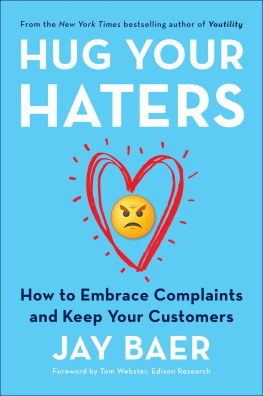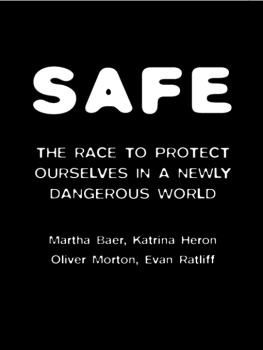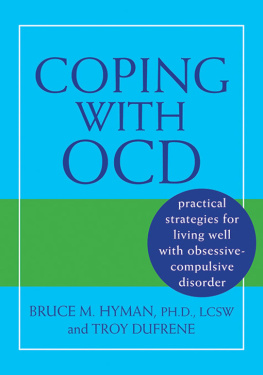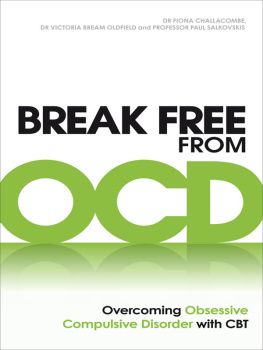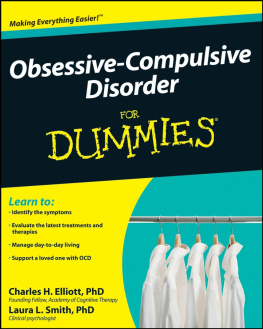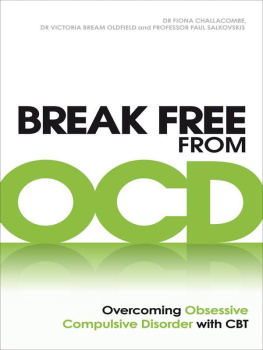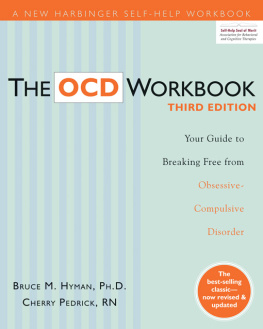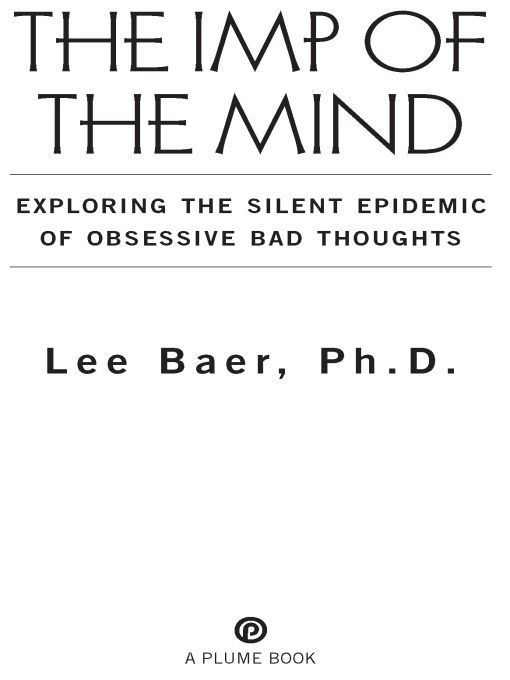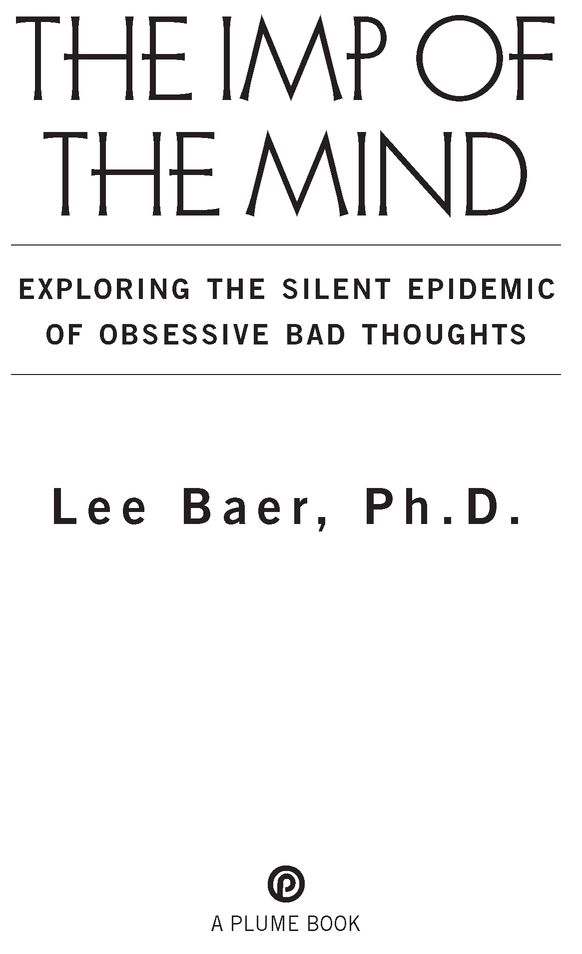Table of Contents
Praise for The Imp of the Mind
Though there is extensive practical information in
The Imp of the Mind, Baer also delves into the
fascinating history of bad thoughts and various ideas
about their origins, which range from evolutionary
theories to Freudian ones.
Chicago Tribune
A beautifully written book about the common
and troublesome problem of intrusive and repetitive
nasty thoughts. It gives excellent advice in
language that is easy to grasp.
Isaac Marks, M.D., author of Living with Fear:
Understanding and Coping with Anxiety
Most individuals with obsessive-compulsive disorder
suffer in anguished isolation because of the profound
embarrassment over their unseemly thoughts and
impulses. Dr. Baer in The Imp of the Mind strips the
stigma from this disorder and offers hope to the
layperson that this remarkably common condition
can be effectively treated.
Joseph T. Coyle, M.D., chairman, department of
Psychiatry, Harvard University
LEE BAER, Ph.D., is an internationally recognized expert in the treatment of OCD and related disorders, and the author of Getting Control: Overcoming Your Obsessions and Compulsions (available in a Plume edition). Dr. Baer is an associate professor of psychology at Harvard Medical School and the director of research of the OCD unit at Massachusetts General Hospital, as well as the OCD Institute at McLean Hospital. He lives near Boston with his wife and two children.
Written by a world leader in the treatment of obsessive-compulsive
disorder, The Imp of the Mind provides
a fascinating, accessible account of how recent clinical
breakthroughs can help people cope with disturbing
intrusive thoughts. Merely reading this excellent book
should provide welcome relief for the many people
suffering from this all-too-common problem.
Richard J. McNally, Ph.D., professor of psychology,
Harvard University
Another masterpiece from Lee Baer, the author of
Getting Control. Dr. Baer dissects the boundaries
between innocent aberrations, obsessive-compulsive
disorder, and dangerous preoccupations, and tells us
clearly what can and should be done about them. Bravo!
John H. Griest, M.D., clinical professor of psychiatry,
University of Wisconsin Medical School
Patients and clinicians alike will benefit from
[Dr. Baers] two decades of experience with these
exceedingly painful symptoms.
Michael A. Jenike, M.D, professor of psychiatry,
Harvard Medical School
With an easy-to-read style, Baer offers a comprehensive
and accessible look at this fascinating topic.
Publishers Weekly
For David and Emily
Acknowledgments
I am pleased to express my gratitude to several groups of people without whom this book would not exist. First, I thank all my patients who suffer with bad thoughts, who have shared their most private secrets with me, and have taught me most of what I know about this problem. I have been touched by the strength of those who have seen improvements in their problem with the treatments described in this book, as well as the courage and good humor of those who remain harshly afflicted, but are nonetheless determined to have the highest quality lives possible despite their problem. I pledge to keep searching for more effective treatments to better assist all of you. I am particularly indebted to all those sufferers of bad thoughts who have shared their experiences with me over the years.
As always, I am indebted to my talented coworkers at Massachusetts General Hospital and McLean Hospital for providing a stimulating work environment and for always being there for support and guidance. I thank Sabine Wilhelm for agreeing to be interviewed about the new developments in cognitive therapy. She, Nancy Keuthen, and Deb Osgood-Hynes graciously provided me with numerous examples of therapy assignments they have used with their patients. Bill Minichiello and Mike Jenike have been my friends and mentors for almost twenty years, and I thank them both for agreeing to be interviewed on religious obsessions and medication treatments, respectively. I thank Cary Savage for agreeing to share in depth his expertise in the neuropsychology and neurophysiology of obsessions. Scott Rauch has sharpened my thinking through many hours of discussion about the overlap between OCD and Tourettes syndrome, and Beth Gershuny called my attention to the fascinating link between post-traumatic stress disorder and obsessions. I thank my psychology colleagues, Mark Blais and Bill Lenderking, for leading our team in developing the quality of life scale included in the final chapter, which is named for Ken Schwartza friend lost too young to cancer. I thank our chief of psychiatry at Mass General, Ned Cassem, for his friendship and support over the years, and for giving permission for reprinting the Schwartz Outcome Scale in these pages. Finally, Linda Leahy provided invaluable support in typing the transcripts of many interviews, and searched far and wide for critical research references.
Many colleagues outside of Mass General have contributed to my research in this area. Kathy Wisner in Cleveland gave generously of her time to share her experiences with postpartum obsessions in new mothers in several interviews and E-mail exchanges. Finally, Isaac Marks in London is always available to discuss new treatment approachesit was he who first called my attention to the early studies of cognitive therapy for obsessionsas well as evolutionary approaches to understanding these and other psychiatric disorders.
At Dutton I thank Deb Brody for first seeing the value of a book on bad thoughts and for encouraging me in pursuing this project. Amanda Patten at Plume stepped in to provide her guidance during the early stages of this project. Finally, Mitch Hoffman, my present editor at Dutton, has made this book far better than it would otherwise have been, through his incisive questions and his wise editing.
Of course this book would not exist at all without the emotional support of my wonderful family. My wife Carole Ann, my son David, and my daughter Emily are the best things in my life, and as usual they were always there to pick me up and carry me through when I was certain this book would never be finished. It is the time I spend with them that recharges me after the hard work of writing and rewriting. My mother, Bernice, and my brother, Larry, have always been strong supporters. The memories of my father Bill, my grandfather Dave, and my grandmother Mary are always with me for inspiration.
As I finish thanking many of those who helped me in the preparation of this book, I take this opportunity to warn that any errors that have found their way onto the following pages are my responsibility alone.
Preface
Ever since Sally, a new mother in her midtwenties, had brought her infant daughter, Jessie, home from the hospital, she had become increasingly afraid of being alone with her. Now, when she has to take care of her daughter alone, she thinks about how easy it would be to throw her defenseless Jessie against a wall and smash her skull, or how quickly she could smother her under her tiny pillow. If Sally sees a knife on the kitchen counter, the image of stabbing Jessie floods her mind, disgusting her and filling her with guilt. Her husband, Jack, finds it odd that Sally always prefers that



